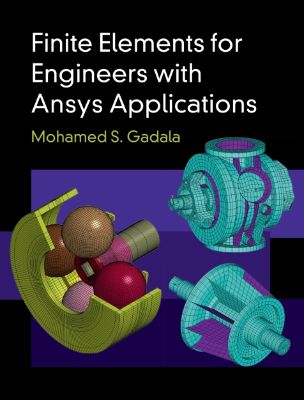Finite Elements for Engineers with Ansys Applications

Lýsing:
The finite element method (FEM) is indispensable in modeling and simulation in various engineering and physical systems, including structural analysis, stress, strain, fluid mechanics, heat transfer, dynamics, eigenproblems, design optimization, sound propagation, electromagnetics, and coupled field problems. This textbook integrates basic theory with real-life, design-oriented problems using ANSYS, the most commonly used computational software in the field.
For students as well as practicing engineers and designers, each chapter is highly illustrated and presented in a step-by-step manner. Fundamental concepts are presented in detail with reference to easy to understand worked examples that clearly introduce the method before progressing to more advanced content. Included are step-by-step solutions for project type problems using modelling software, special chapters for modelling and the use of ANSYS and Workbench programs, and extensive sets of problems and projects round out each chapter.
Annað
- Höfundur: Mohamed S. Gadala
- Útgáfudagur: 2020-07-09
- Engar takmarkanir á útprentun
- Engar takmarkanir afritun
- Format:Page Fidelity
- ISBN 13: 9781316998175
- Print ISBN: 9781107194083
- ISBN 10: 1316998177
Efnisyfirlit
- Half-title page
- Title page
- Copyright page
- Contents
- Preface
- 1 Finite Element Concepts
- Chapter Roadmap
- 1.1 General Solution of Continuum Problems
- 1.2 What is the Finite Element Method?
- 1.3 Basic Concepts and Definitions
- 1.4 Element Types and Degrees of Freedom (DOFs)
- 1.4.1 Truss Elements
- 1.4.2 Beam Elements
- 1.4.3 Two-Dimensional Elements
- 1.4.4 Three-Dimensional Shell Elements
- 1.4.5 Three-Dimensional Solid Elements
- 1.5 General Procedures for Finite Element Analysis
- 1.5.1 Basic Procedures in Finite Element Analysis
- 1.5.2 Phases of Finite Element Analysis in Commercial Programs
- 1.6 Brief History of the Development of the FE Method
- 1.6.1 Ancient Roots of the FE Method
- 1.6.2 History of the Development of the FE Method
- 1.6.3 History of the Development of Computers and FE Software Programs
- Early Software Development
- The Law-of-the-Land (Moore's)
- The Pre-Personal-Computer Era
- 64 Bits and Parallelization
- 1.6.4 Future Outlook and What's Next?
- 1.7 Finite Element Applications
- 1.7.1 Various Types of Application
- 2 Detailed Procedures
- Chapter Roadmap
- 2.1 Element Characteristic Equations for Simple Elements
- 2.1.1 Simple Truss Element – One DOF per node
- 2.1.2 One-Dimensional Heat Transfer Element
- 2.1.3 Pipe Flow Element
- 2.1.4 Direct Current Flow Element
- 2.1.5 Torsional Element
- 2.2 Simple Beam Element
- 2.3 Assembling of Global Equations
- 2.4 Application of Boundary Conditions
- 2.4.1 Rigid Body Motion
- 2.4.2 Applying Boundary Conditions
- 2.4.3 Application Example: Beam Element with a Hinge
- 2.5 Coordinate Transformations and More Element Equations
- 2.5.1 Coordinate Transformation
- 2.5.2 General Two-Dimensional Truss Element
- 2.5.3 General Two-Dimensional Beam Element
- 2.5.4 Three-Dimensional Truss Element
- 2.5.5 Three-Dimensional Beam Element
- Problems
- 3 Modeling Aspects
- Chapter Roadmap
- 3.1 The Modeling Process
- 3.2 Geometric Modeling
- Problems
- Key Points
- Line or Line Segment
- Area or Patch
- Volume or Hyperpatch
- Boolean Operations
- Theory of Parametric Cubic Geometry
- 3.3 Discrete Element Types in FE Programs
- 3.3.1 Concentrated Mass–Inertia Elements
- 3.3.2 Spring and Damper Elements
- 3.4 Problem Classification and Element Choice
- 3.4.1 Truss and Beam Problems
- 3.4.2 Two-Dimensional Problems
- (i) 2D Plane Stress Problems
- (ii) 2D Plane Strain Problems
- (iii) 2D Axisymmetric Problems
- 3.4.3 Shell Problems
- 3.4.4 Three-Dimensional Solid Problems
- 3.5 Synopsis of Problem Classification and Element Choice
- 3.6 Symmetry Considerations
- 3.6.1 Planar Symmetry
- 3.6.2 Axial Symmetry
- 3.6.3 Cyclic Symmetry
- 3.6.4 Symmetric Structure with Non-Symmetric Loading
- 3.7 Boundary Conditions
- 3.7.1 Eliminating Rigid Body Motion
- 3.7.2 Modeling Supports
- 3.8 Mesh Intensity and Transition
- 3.9 Modeling with Different Element Types
- 3.10 Lumped Load Vectors
- 3.10.1 Lumped Load Methods
- 3.10.2 Node-by-Node Lumping
- 3.10.3 Element-by-Element Lumping
- 3.11 Model Checking
- 3.11.1 Checks Initiated by the Program
- 3.11.2 Checks Performed by the User
- 3.12 General Modeling Hints
- Problems
- 4 Linear Static Analysis Using Ansys/Workbench
- Chapter Roadmap
- 4.1 Introduction to the Ansys Program
- 4.1.1 Operation Modes in Ansys
- 4.1.2 Starting up Ansys
- 4.1.3 Windows in Ansys
- 4.1.4 Ansys Structure and Files
- 4.2 Ansys Project 1: Analysis of a 2D Support Bracket
- 4.2.1 Problem Description
- 4.2.2 Create the Model Geometry
- 4.2.3 Generate the FE Model
- 4.2.4 Solution Operation
- 4.2.5 Displaying the Results and Exiting Ansys
- 4.2.6 Batch Type Solution
- 4.2.7 Mesh Sensitivity Analysis
- 4.3 Introduction to Workbench
- 4.3.1 Layout of Program Menus
- 4.3.2 Overview of the Geometry and the DesignModeler Capabilities
- 4.4 Workbench Project 1: 2D Cantilever Bracket
- 4.4.1 Create the Model Geometry
- 4.4.2 Generate the FE Model
- 4.4.3 Solution, Results and Mesh Refinement
- 4.5 Workbench Project 2: 3D T-Junction Analysis
- 4.5.1 Problem Description
- 4.5.2 Creating the Geometry
- 4.5.3 T-Junction FE Model and Solution
- 5 Finite Element Formulations
- Chapter Roadmap
- 5.1 Overview
- 5.2 Strong and Weak Forms of the Problem
- 5.3 FE Virtual Work Formulations
- 5.4 Principle of Minimum Potential Energy and the Rayleigh–Ritz Method
- 5.5 Linear Elastic FE Analysis Using Virtual Work Principle
- 5.6 Heat Conduction Analysis Using Virtual Work Principle
- 5.7 Method of Weighted Residuals (MWRs)
- 5.7.1 Overview of MWRs
- 5.7.2 Various Weighted Residual Methods
- Continuous Least Squares Method
- Least Squares Collocation Method
- Galerkin Methods
- 5.8 Galerkin Formulation of 2D Linear Elasticity Problems
- 5.9 Formulation of Heat Conduction Analysis
- 5.9.1 Heat Conduction Analysis Using Variational Principles
- 5.9.2 3D Heat Conduction Analysis Using the Galerkin Formulation
- Problems
- Project Type Problems
- 6 Linear Static Analysis
- Chapter Roadmap
- 6.1 Linear Elastic Analysis Formulation
- 6.1.1 Problem Formulation by the Virtual Work and Galerkin Principles
- 6.1.2 Specialization to Two-Dimensional Problems
- 6.2 Application to General Three-Dimensional Solid Elements
- 6.3 Development of Simple Beam Element
- 6.4 Development of Two-Dimensional Elements
- 6.4.1 Plane Stress or Strain Triangular Element with Three Nodes
- 6.4.2 Plane Stress or Strain Rectangular Element with Four Nodes
- 6.4.3 Axisymmetric Triangular Ring Element with Three Nodes
- 6.5 Development of Three-Dimensional Solid Elements
- 6.5.1 Tetrahedron Element with Four Nodes
- 6.6 Thermal Stresses
- 6.6.1 Constitutive Equations with Thermal Effect
- 6.6.2 Element Equations with Thermal Effect
- 6.7 Isoparametric Elements
- 6.7.1 General Concepts and the Need for Isoparametric Elements
- 6.7.2 Development of 1D Truss Element
- 6.7.3 Development of 2D Quadrilateral Element with Four to Nine Nodes
- 6.7.4 Development of 2D Triangular Element with Three to Six Nodes
- 6.7.5 Development of 3D Hexahedral or Cubical Element with Eight to 20 Nodes
- 6.7.6 Development of 3D Tetrahedral Elements
- 6.8 Application of Multi-Point Linear Constraint Equations (MPCs)
- 6.8.1 Types of Constraint
- 6.8.2 Method of Substitution
- 6.8.3 Lagrange Multiplier Method
- 6.8.4 Penalty Method
- Problems
- Multiple Choice Questions
- 7 Conduction Heat Transfer Analysis
- Chapter Roadmap
- 7.1 General Background
- 7.1.1 Basic Modes of Heat Transfer
- (i) Conduction
- (ii) Convection
- (iii) Radiation
- 7.1.2 The One-Dimensional Heat Conduction Equation
- 7.1.3 Boundary Conditions
- 7.1.4 Sources of Nonlinearity
- 7.1.1 Basic Modes of Heat Transfer
- 7.2 FE Formulation of the Heat Conduction Problem
- 7.3 Solution of the Transient Heat Transfer Equations
- 7.3.1 General Considerations
- 7.3.2 Direction Integration Method
- (i) Linearization of the General Equation
- (ii) The α-Method
- (iii) General Solution Steps
- (iv) Stability and Accuracy Considerations
- (v) Accuracy of the α-Method
- 7.4 Element Equations for Heat Transfer Analysis
- 7.4.1 One-Dimensional Elements
- 7.4.2 Two-Dimensional Elements
- (i) Three-Node Plane Triangular Elements
- (ii) Three-Node Axisymmetric Elements
- (iii) Isoparametric Elements
- 7.5 Ansys/Workbench Project: Square Plate with Prescribed Temperature Boundary Conditions
- Problem Statement
- Approach and Assumptions
- Solution Steps
- (1) Specifying the Physics Problem
- (2) Engineering Data
- (3) Ansys Design Modeler
- (4) Ansys Workbench Modeling
- (5) Ansys Workbench Solver
- (6) Ansys Workbench PostProcessor
- (7) Comparison (Figure P1-13)
- Problems
- Project Type Problems
- Appendix A Matrices and Systems of Linear Equations
- Appendix B Vectors and Tensors
- References
- Index
UM RAFBÆKUR Á HEIMKAUP.IS
Bókahillan þín er þitt svæði og þar eru bækurnar þínar geymdar. Þú kemst í bókahilluna þína hvar og hvenær sem er í tölvu eða snjalltæki. Einfalt og þægilegt!Rafbók til eignar
Rafbók til eignar þarf að hlaða niður á þau tæki sem þú vilt nota innan eins árs frá því bókin er keypt.
Þú kemst í bækurnar hvar sem er
Þú getur nálgast allar raf(skóla)bækurnar þínar á einu augabragði, hvar og hvenær sem er í bókahillunni þinni. Engin taska, enginn kyndill og ekkert vesen (hvað þá yfirvigt).
Auðvelt að fletta og leita
Þú getur flakkað milli síðna og kafla eins og þér hentar best og farið beint í ákveðna kafla úr efnisyfirlitinu. Í leitinni finnur þú orð, kafla eða síður í einum smelli.
Glósur og yfirstrikanir
Þú getur auðkennt textabrot með mismunandi litum og skrifað glósur að vild í rafbókina. Þú getur jafnvel séð glósur og yfirstrikanir hjá bekkjarsystkinum og kennara ef þeir leyfa það. Allt á einum stað.
Hvað viltu sjá? / Þú ræður hvernig síðan lítur út
Þú lagar síðuna að þínum þörfum. Stækkaðu eða minnkaðu myndir og texta með multi-level zoom til að sjá síðuna eins og þér hentar best í þínu námi.
Fleiri góðir kostir
- Þú getur prentað síður úr bókinni (innan þeirra marka sem útgefandinn setur)
- Möguleiki á tengingu við annað stafrænt og gagnvirkt efni, svo sem myndbönd eða spurningar úr efninu
- Auðvelt að afrita og líma efni/texta fyrir t.d. heimaverkefni eða ritgerðir
- Styður tækni sem hjálpar nemendum með sjón- eða heyrnarskerðingu
- Gerð : 208
- Höfundur : 18651
- Útgáfuár : 2020
- Leyfi : 380






















